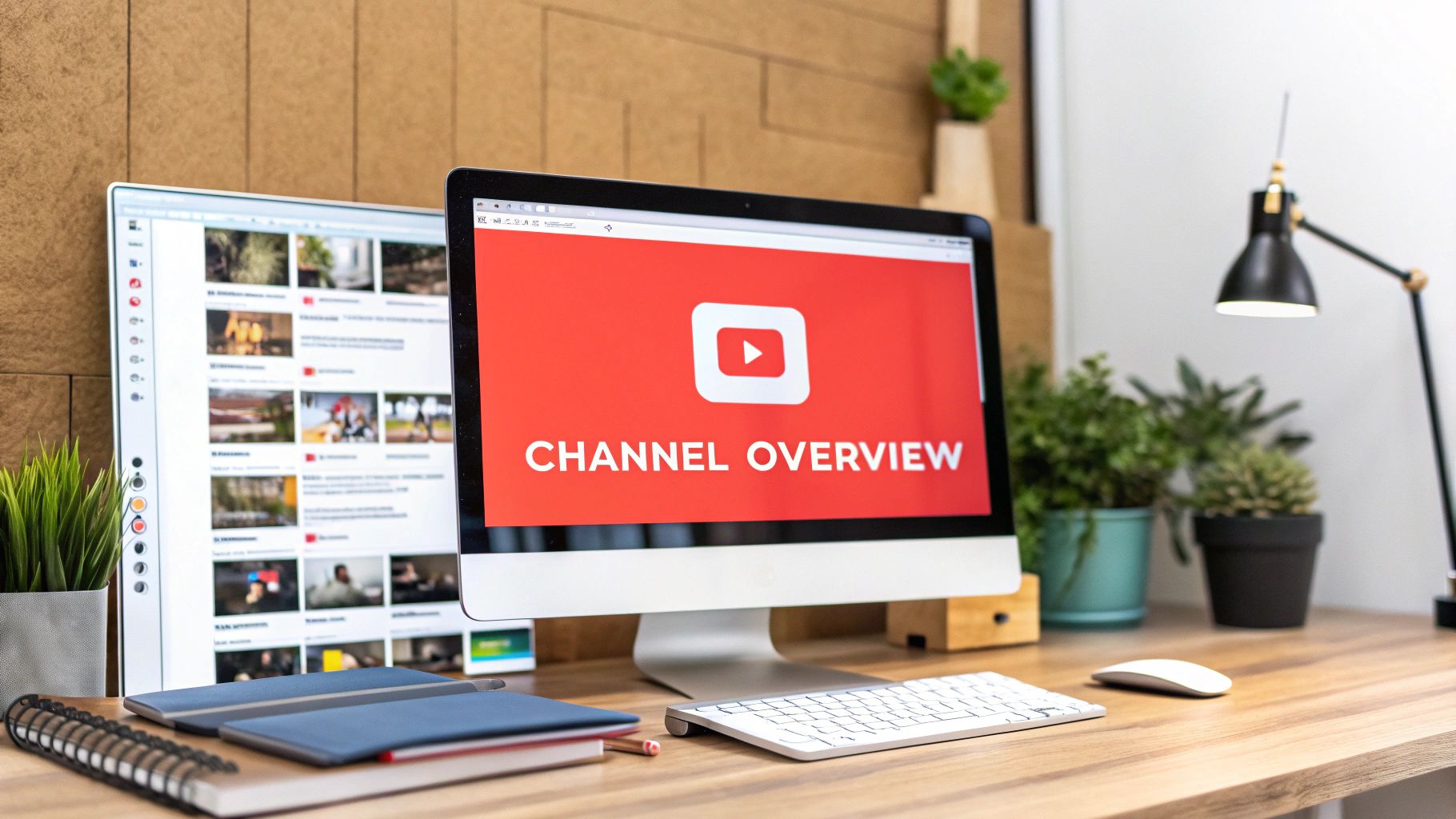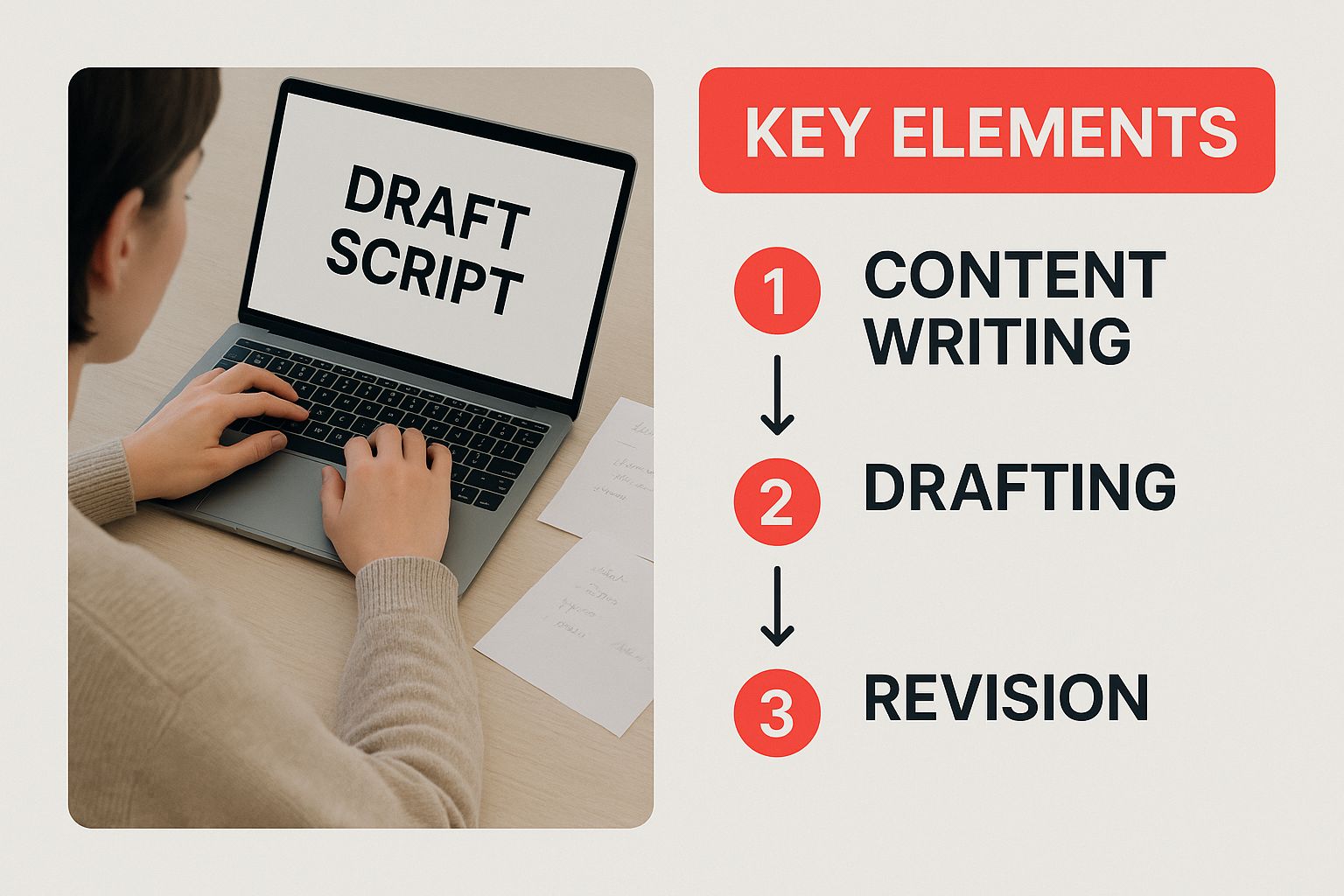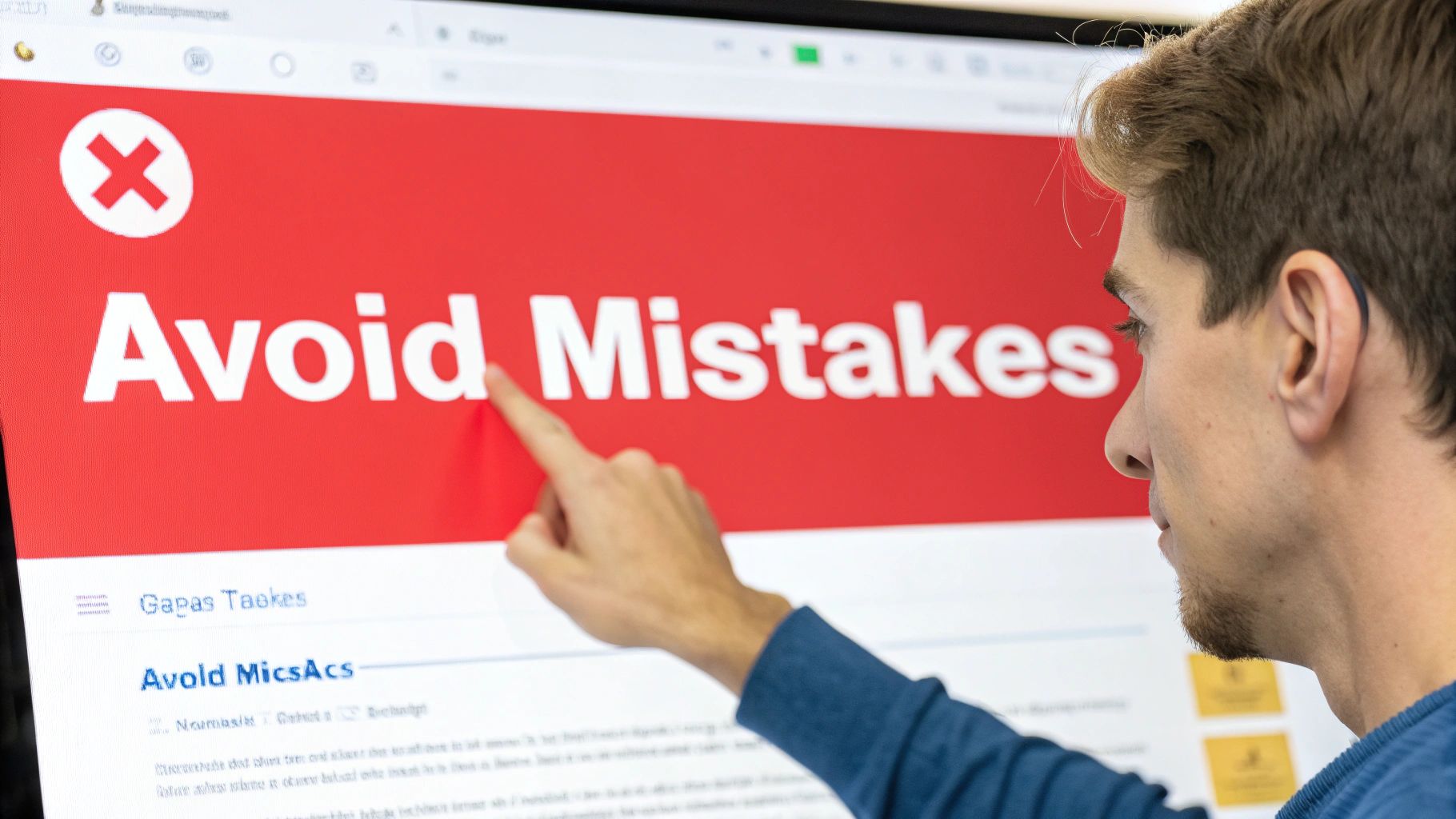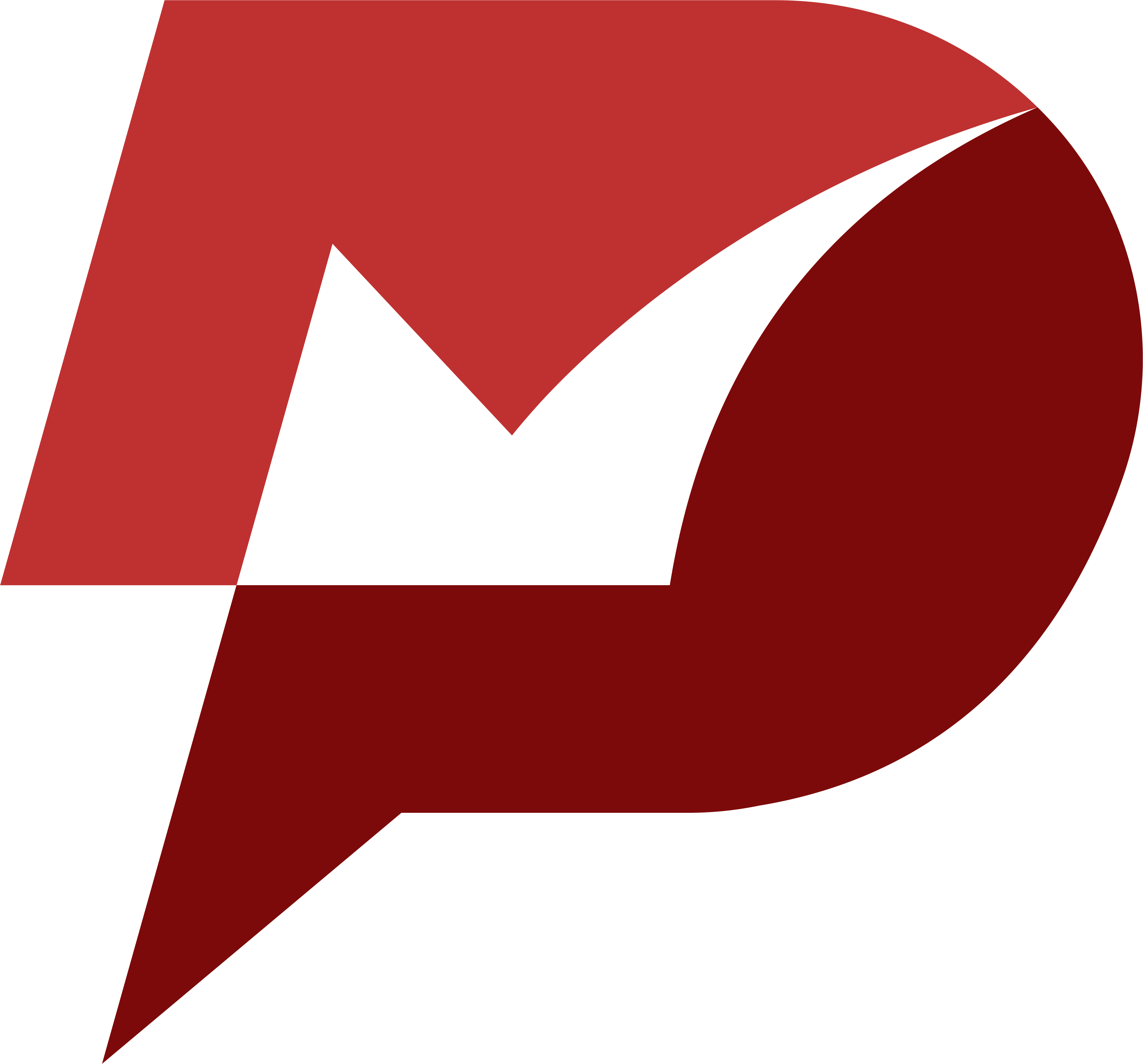Your YouTube channel description is that little block of text on your "About" page that tells the world—and the YouTube algorithm—what you're all about. It’s your elevator pitch, brand statement, and SEO powerhouse all rolled into one.
Why Your Channel Description Is a Growth Engine

It’s so easy to treat your channel description as an afterthought. You're focused on making great videos, so you scribble down a quick paragraph and forget about it. Big mistake. That small space is one of the most valuable tools you have for turning casual viewers into loyal subscribers.
This isn’t just about telling people what you do; it's your direct line to YouTube's discovery system.
With over 114 million active YouTube channels out there, you need every advantage you can get to stand out. A well-written description does a lot of heavy lifting for you, and it’s crucial for your channel's long-term success.
Your First Impression with Viewers
Before someone even watches a single video, they might click over to your "About" page. This is your shot to make a real connection.
A great description answers a few key questions right away:
- Who is this channel for?
- What kind of videos can I expect?
- Is there a regular upload schedule?
Nailing this helps a potential viewer immediately decide if your channel is a good fit for them. Get it right, and you've got a new subscriber.
A Powerful Signal to the Algorithm
Your description isn't just for human eyes—it's also a roadmap for the YouTube algorithm. When you strategically include keywords about your niche, your content style, and your target audience, you're basically telling YouTube exactly who needs to see your channel.
This is how you get your videos to pop up in recommended feeds and search results for people who are actively looking for the content you create. For a complete look at promoting your channel, don't miss our guide on https://monetizedprofiles.com/blogs/monetization-on-social-media/how-to-market-youtube-channel.
To really get this right, you need to understand the core pieces that make a description work. Here's a quick breakdown of the essential elements.
Core Components of a High-Performing Channel Description
A quick look at the essential elements your YouTube channel description needs to both attract viewers and satisfy the algorithm.
| Component | What It Does | Example Snippet |
|---|---|---|
| The Hook | Grabs attention in the first sentence; clearly states the channel's value. | "Helping busy professionals cook healthy, 15-minute meals." |
| Value Proposition | Explains what's in it for them—the benefit the viewer gets. | "...so you can eat well without spending hours in the kitchen." |
| Content & Niche | Specifies the topics, video types, and overall theme of the channel. | "I share weekly recipe tutorials, kitchen hacks, and grocery hauls." |
| Keywords | Includes search terms your ideal viewer would use to find you. | "quick weeknight dinners, easy recipes, healthy cooking" |
| Call-to-Action (CTA) | Tells the reader what to do next (subscribe, follow on social). | "Subscribe for new videos every Tuesday!" |
Think of these components as your recipe for a description that actually drives growth.
Your YouTube channel description is more than a simple bio. It’s a strategic tool that defines your brand, guides the algorithm, and serves as your first handshake with a potential fan.
And it doesn't stop there. A clear, compelling description can also make you more visible to brands. When your value proposition is crystal clear, you can attract brands seeking UGC creators for partnerships and sponsorships. Don't treat it like a chore; see it for what it is—a core part of your growth strategy.
Breaking Down a Description That Actually Converts
A great YouTube channel description isn't just a block of text; it's a strategic welcome mat. From my experience, the best ones aren't written by accident. They follow a simple, effective flow: hook the viewer, show them the value, and then tell them what to do next. It's a surprisingly simple formula for turning a random visitor into a dedicated subscriber.
The most critical part? The very beginning. You have to remember that in search results on YouTube or Google, people often only see the first 150 characters. That tiny snippet has to do all the heavy lifting to get them to click.
Nail the Perfect Hook
Think of your first sentence as your elevator pitch. It has to be quick, packed with keywords, and all about what the viewer gets out of it. Ditch the generic "Welcome to my channel" and get straight to the point.
For instance, if you run a fitness channel, don't just say you post workouts. Try something like, "Your go-to source for 20-minute home workouts that deliver real results." It's direct, it uses terms people are searching for ("home workouts"), and it makes a clear promise. You're showing respect for their time and setting clear expectations from the get-go.
A powerful hook doesn’t just describe your videos; it sells the solution your channel offers. It’s the difference between saying, “I make cooking videos,” and “Learn how to cook incredible meals in under 30 minutes.”
This handy graphic breaks down the essential pieces of a solid channel description.

As you can see, it's a natural progression. You grab their attention, explain why they should stick around, and then give them a clear next step.
Flesh Out Your Value Proposition
Once you've hooked them, it's time to reel them in. The middle of your description is where you expand on that initial promise and really sell your channel. Get specific about what makes you unique and why they should pick you over the countless other channels in your niche.
This is the perfect spot to lay out the details:
- What you make: Do you post tutorials, reviews, vlogs, or interviews? Let them know.
- When you post: Give them a reason to come back. ("New videos every Tuesday!")
- Who it's for: Speak directly to your ideal viewer. ("Perfect for busy entrepreneurs" or "A community for beginner artists.")
This section is also your prime real estate for weaving in secondary keywords. If your main keyword is "vegan recipes," you can naturally work in phrases like "plant-based meals," "easy vegan cooking," or "healthy diet tips."
Finish with a Strong Call to Action
Alright, you've made your case. Now what? Don't leave your potential subscriber hanging. You have to tell them exactly what to do next.
A simple "Subscribe for more!" is fine, but you can do better. A call to action (CTA) is your chance to start building a real relationship. For more great ideas on writing compelling copy, checking out guides on Mastering Social Media Content Creation can be a huge help.
Think beyond just the subscribe button. Ask them to follow you on Instagram, join your newsletter, or drop a comment on a video. The goal is to turn that passive viewer into an active member of your community. A good CTA is the final step that transforms a casual browser into a true fan.
Finding Keywords That Get Your Channel Discovered
Let's talk about SEO, but without the confusing jargon. Your YouTube channel description is more than just a bio—it’s a direct signal to the YouTube algorithm, telling it who your videos are for. Getting this right isn't some dark art; it's about getting inside the head of your ideal viewer. The whole point is to figure out the exact words they’re typing into that search bar and then sprinkle them naturally into your description.
This is a bigger deal than you might think. YouTube's algorithm drives 70% of what people watch, so feeding it the right information is crucial. This is how you show up in search results and pop into those "recommended for you" feeds, connecting you with people who are already looking for content just like yours.
Start with the YouTube Search Bar
Your best friend for this is right on YouTube's homepage. The search bar is simple, free, and gives you a direct line into the mind of your audience.
Just start typing a broad topic about your niche. Let's say your channel is all about home organization. Type "home organization" and pause.
Look closely at the autocomplete suggestions that appear. These aren't just random guesses; they're the most popular searches related to your topic. You’ll probably see things like:
- home organization for small spaces
- home organization hacks
- home organization on a budget
These phrases are pure gold. They tell you the specific problems your viewers are trying to solve. Every single one is a potential keyword you can weave into your channel description.
Understand Your Audience's Intent
Just grabbing keywords isn't enough. You have to understand the why behind the search. Are people looking for a quick tip, a deep-dive tutorial, or a product review? Answering that question helps you write a description that promises exactly what they need.
If you haven't already mapped out who you're talking to, now's the time. For some powerful insights on this, check out our guide on how to identify your target audience.
Once you have a solid list of keywords, go search for them on YouTube. Take a look at the top-ranking videos. What words do they use in their titles and descriptions? The goal isn't to copy them, but to spot patterns in the language that clearly resonates with viewers for that topic.
The biggest mistake I see is creators just dumping a list of keywords into their description. The real magic happens when you use these phrases to build natural, compelling sentences that tell a story about the value you offer.
Weaving Keywords into Your Description
Okay, let's bring it all together. You’ve got your keywords and you know what your audience is after. The last piece of the puzzle is to work these terms into your description so it sounds like a human wrote it.
Don't just make a list. Use your keywords to answer the viewer's unspoken questions.
Example Scenario: A "Home Organization" Channel
Instead of this robotic approach: "Keywords: home organization, decluttering, small spaces, budget organizing."
Try something more like this: "Welcome! I'm here to help you with practical home organization ideas, especially if you're dealing with small spaces. My videos are full of simple decluttering tips and clever home organization hacks that actually work, even if you're on a budget. Subscribe for weekly inspiration to finally create a calm, organized home you love."
See the difference? This version is friendly, helpful, and naturally packed with the very phrases your ideal viewer is searching for. That’s how you get discovered.
Crafting a Description for a Global Audience
Your YouTube channel isn't just for your local audience; it's a global stage. Viewers from all over the world can stumble upon your videos at any time, which means your channel description needs to be welcoming to everyone. This doesn't mean you need complex translations—it's more about making small, inclusive tweaks that can make a huge difference.
First things first, get a real sense of who's watching. Pop over to your YouTube Analytics and click on the "Geography" tab. You might be genuinely surprised to see where your views are coming from. If you notice a big chunk of your audience is from a non-English-speaking country, that's a golden opportunity to connect with them on a deeper level.
Speaking Their Language Simply
You don't have to be a polyglot to make your channel feel more inclusive. Often, a few thoughtful additions are all it takes.
Here are a few simple but effective things you can try:
- A Simple Welcome: Add a short, translated welcome message for your top one or two non-English speaking audiences. Something as simple as "Bienvenido a mi canal!" (Welcome to my channel!) is a warm nod to your Spanish-speaking fans.
- Keep It Clear: Try to avoid really complex slang or cultural inside jokes that might get lost in translation. Sticking to clear, direct language helps your core message land with everyone.
- Use Visual Cues: Emojis are your friend here! They break through language barriers instantly. A 📈 for a business channel or a 🎨 for an art channel quickly tells people what you're all about.
It's eye-opening to see the numbers. As of early 2025, India leads the pack with around 491 million YouTube users, with the United States and Brazil right behind. This incredible geographic spread shows why thinking globally is no longer optional. For more details, you can check out some fascinating global YouTube user statistics on globalmediainsight.com.
Inclusive Branding Beyond Words
Your global appeal is tied directly to your overall brand. How you present your channel in your description says a lot about your awareness and professionalism. A clear, inclusive message is a key piece of building a brand with an international footprint.
For more on this, we've put together a comprehensive social media branding guide that dives deeper into creating a brand that connects with people everywhere.
Thinking globally isn't just about translating words; it's about translating your channel's value to a much bigger audience. A little effort here can pay off with huge growth and loyalty from viewers around the world.
Remember, the goal is connection, not perfection. You don't need a perfectly translated description in ten different languages. A simple, thoughtful approach that shows you see and appreciate your diverse audience is what will truly set your channel apart.
Common Description Mistakes That Hurt Your Growth

We all learn from mistakes, but learning from someone else's is a whole lot less painful. When it comes to the description a YouTube channel uses, a few common blunders can quietly sabotage your growth, turning potential subscribers away before they even watch a single video.
Think of your "About" page as your digital storefront. If it's messy, confusing, or just plain boring, people are going to walk right on by. By steering clear of these common traps, you can make sure your channel description is actually helping you, not holding you back.
Forgetting Who You Are Talking To
This is easily the biggest mistake I see. Creators write a description that’s all about them—their passions, their accomplishments, their life story. But here's the hard truth: a new visitor doesn't care about you yet. They only care about what you can do for them.
Every potential subscriber is subconsciously asking, "What's in it for me?"
Instead of framing everything around your personal journey, shift the focus to the value you provide for them. A description full of personal anecdotes won't connect nearly as well as one that promises to solve a specific problem or entertain them in a way nobody else does.
Your description is a conversation starter. If you only talk about yourself, you’ll lose the other person's interest before the conversation even begins.
For instance, a travel vlogger might be tempted to write about their lifelong dream of seeing the world. A much smarter approach? Focus on how their videos help viewers plan their own incredible, budget-friendly adventures. See the difference?
Using Awkward Keyword Stuffing
Look, I get it. SEO is important. But just dumping a clunky list of keywords into your description is a massive turn-off for both real people and the YouTube algorithm. It reads like a robot wrote it and screams that you're trying to cheat the system.
A much better strategy is to weave your keywords into natural, flowing sentences. This way, you're still signaling to the algorithm what your channel is about, but you're doing it in a way that’s welcoming to a human reader.
Let’s look at a quick before-and-after.
| Before (Keyword Stuffing) | After (Natural Integration) |
|---|---|
| "My channel has: baking tutorials, cake decorating, easy recipes, dessert ideas, cupcake recipes." | "I share easy-to-follow baking tutorials and cake decorating tips. Subscribe for new dessert ideas, from simple cupcake recipes to show-stopping celebration cakes!" |
The "After" version uses all the same key terms, but it does so in a friendly, inviting way that actually explains the channel's value.
Neglecting the Call to Action
Another common fumble is leaving the reader hanging. You’ve hooked them with a great pitch, you've shown them what your channel is all about, and then... crickets. You have to tell them what to do next.
And I don't just mean a lazy "Subscribe!" Get specific and give them a reason to engage further.
- Ask a question: "What recipe should I tackle next? Let me know in the comments of my latest video!"
- Direct them elsewhere: "For behind-the-scenes fun, follow me over on Instagram."
- Offer a freebie: "Grab my free weekly meal planner from the link on my website."
A strong, clear call to action is the final nudge that turns a curious visitor into a loyal member of your community. Don't skip it.
Got Questions? I've Got Answers
Even with the best guide, a few specific questions always seem to pop up when you're staring at that blank description box. Let's tackle some of the most common ones I hear from creators. Getting these details right can be the difference between a description that just sits there and one that actively works for you.
How Often Should I Update My Channel Description?
Think of your channel description like a quick check-in. I recommend giving it a once-over every 3-6 months. Has your content changed? Maybe you started a new series or switched up your upload schedule.
Any time you make a significant shift in your channel's direction or brand, your description needs to reflect that. It’s a simple way to keep your page fresh and accurate for anyone who stumbles upon your channel. Plus, keeping things current tells the YouTube algorithm your channel is active and relevant, which never hurts your chances of getting discovered.
What’s the Perfect Length for a Channel Description?
YouTube gives you 1,000 characters, but you definitely don’t need to use them all. I’ve found the sweet spot is somewhere between 300 and 500 characters.
Your first 125-150 characters are pure gold. That's the snippet people see in YouTube search results, so it has to nail your channel's purpose and include your most important keyword right away.
After that, you have room to breathe. Use the rest of the space to add a little more detail, mention your schedule, drop in some secondary keywords, and link out to your website or social media.
Should I Use Emojis in My Description?
Yes, but with a purpose! Emojis are fantastic for adding personality and making your description easier to scan. They can break up a wall of text and draw the eye to the important stuff.
Here’s how you could use them:
- 📅 Schedule: New videos every Tuesday & Friday!
- 🔗 Links: Follow me on Instagram for behind-the-scenes content.
- 🎯 Niche: Your home for 15-minute healthy recipes 🥗.
The trick is to make sure they match your brand's vibe. If you run a serious channel on personal finance, you might use them sparingly. But for a gaming or comedy channel? Go for it. The goal is to make your description more readable, not more cluttered.
Where Are the Best Places to Find Keywords?
You don’t need to shell out for fancy tools to get started. The best keyword research tool is right in front of you: the YouTube search bar.
Start typing in topics related to your niche and see what YouTube suggests. Those autocomplete phrases are what real people are searching for. It's a direct line into your audience's brain.
Another great trick is to do a little friendly spying on the top channels in your field. Check out their "About" pages and video descriptions. What words and phrases do they use over and over? You’re not looking to copy them, but to spot the patterns and see what language is already working to attract viewers and signal relevance to the algorithm.
Ready to skip the slow grind and start earning from your content immediately? MonetizedProfiles offers fully approved YouTube accounts that are monetized from day one. It's the perfect solution for creators who want to focus on making great videos without waiting to meet monetization requirements. Find your ready-to-go channel at https://monetizedprofiles.com.









